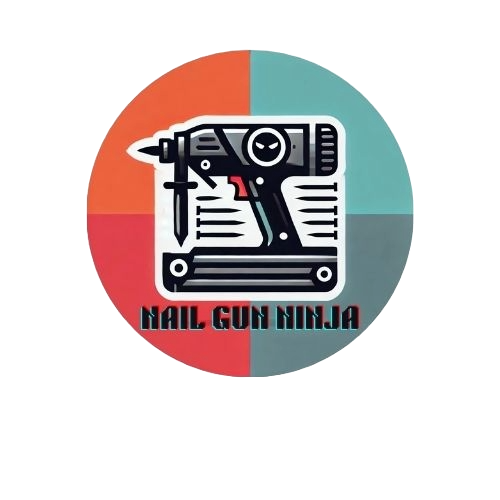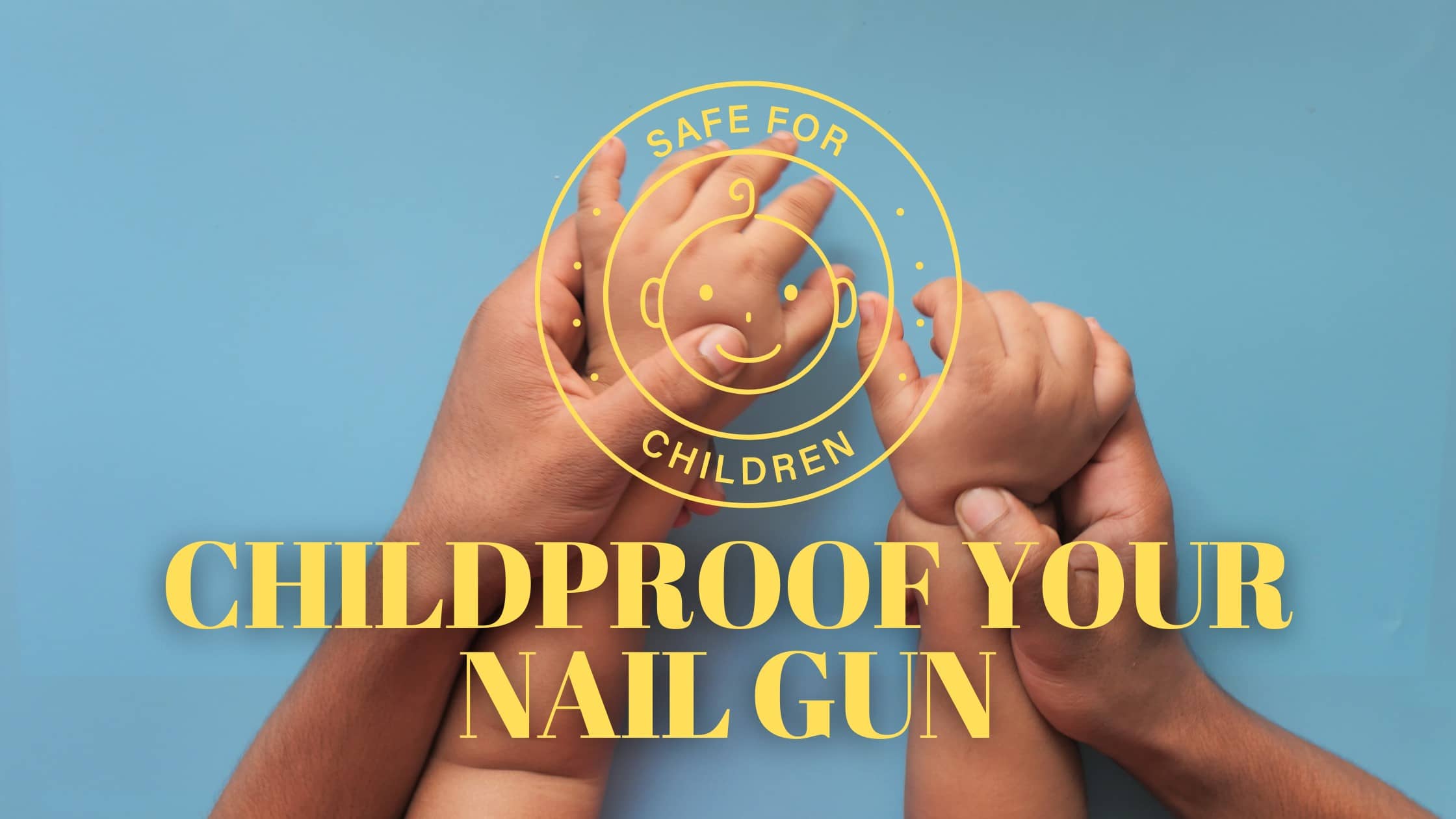After five years of working with nail guns, I am convinced that things can go wrong even when you’re most prepared—especially with kids around. One moment, you’re focused on a project, and the next, there’s a potential accident.
I heard about one member of our forum who was working when his daughter wandered nearby. He was trying to get the trim right, and when he pulled the trigger, the nail grazed her leg. The wound was small, but she screamed out of fear and pain.
Nail gun childproofing defines the importance of nail gun safety for kids or under-aged people. Nail guns make tasks easier, but they can also be dangerous if not handled with care. In this guide, I’ll share the best tips to childproof your nail guns to avoid unexpected accidents.
Understanding the Risks of Nail Guns Around Children
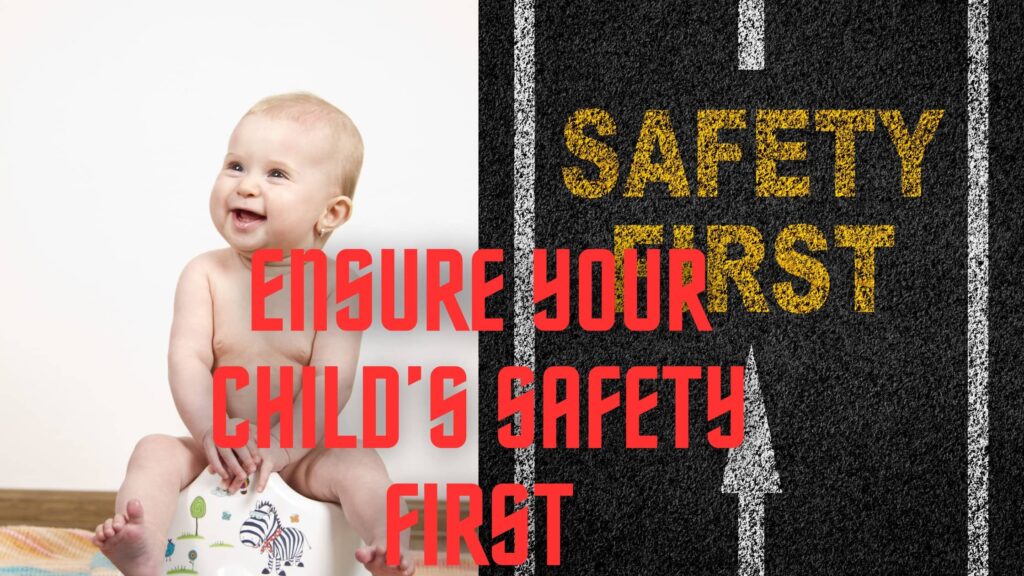
Nail guns are designed to fire nails at high velocity. Even slight contact between a fired nail and skin can be dangerous, while more severe accidents can result in bleeding, deep tissue damage, or even bone injury.
Children have softer tissues and immature bones. Additionally, curious children might mistake nail guns for toys and attempt to “play” with them, increasing the risk of accidents. Also, electric nail guns use electricity which is another common hazard for accidents.
It’s essential not to store nail guns in open or unlocked areas, as this makes them easily accessible. Beyond the nail gun itself, children might swallow loose nails or other small parts, posing a choking hazard. They also might trip on the hose if the hazards of working with pneumatic nail guns are not managed well.
Therefore, both children and adults need to be aware of the risks associated with nail guns and, if possible, receive proper training.
Psychological Approaches to Prevent Children’s Curiosity

Children are naturally curious. Often, when risks are explained to them, they either become afraid or more drawn to the risky item. Instead, use relatable language to explain that these tools serve specific purposes and can be harmful if misused.
Provide safe alternatives, like toy tools, to satisfy their curiosity. Clearly explain that there are specific rules for using these tools and these rules are in place for their safety.
Engaging older kids in simple projects under supervision can help them understand tool safety. You can create fun activities, such as crafting or assembling safe kits, to channel your curiosity securely.
Finally, if you have any past stories regarding nail gun safety mechanisms you can share them. It will help them understand the importance of caution around tools.
Teaching Kids About Tool Safety
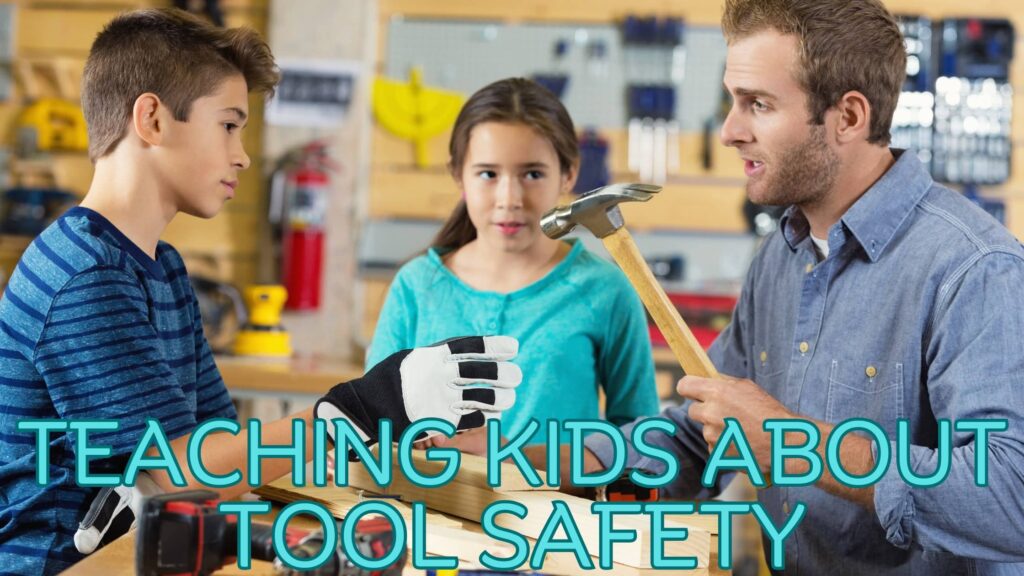
Explain the risks of nail guns
Explain the risks of nail guns in simple, age-appropriate language. Use relatable examples to emphasize that nail guns are tools, not toys, and they can cause harm if used incorrectly.
Interactive safety videos
Use interactive safety videos to engage children. These methods make learning about tool safety fun and memorable for kids.
Set clear rules
Set clear rules for tool areas. Establish consistent guidelines to ensure safety zones are respected.
Parents are role models
Demonstrate parental responsibility as role models. Show children how you store and handle tools responsibly so they can learn appropriate behavior.
Teaching safety icons
Teach children to recognize warning labels and hazard symbols. Understanding safety icons helps kids identify potential dangers.
Encourage question-asking
Create an open dialogue so kids feel comfortable asking questions about tools and their risks.
Provide alternatives
Offer alternatives to nail guns, like toy tool kits, to satisfy their curiosity while teaching the concept of caution.
Remind lessons regularly
Provide periodic reminders and practice safety lessons to ensure that knowledge remains fresh.
Best Childproofing Features for Nail Guns
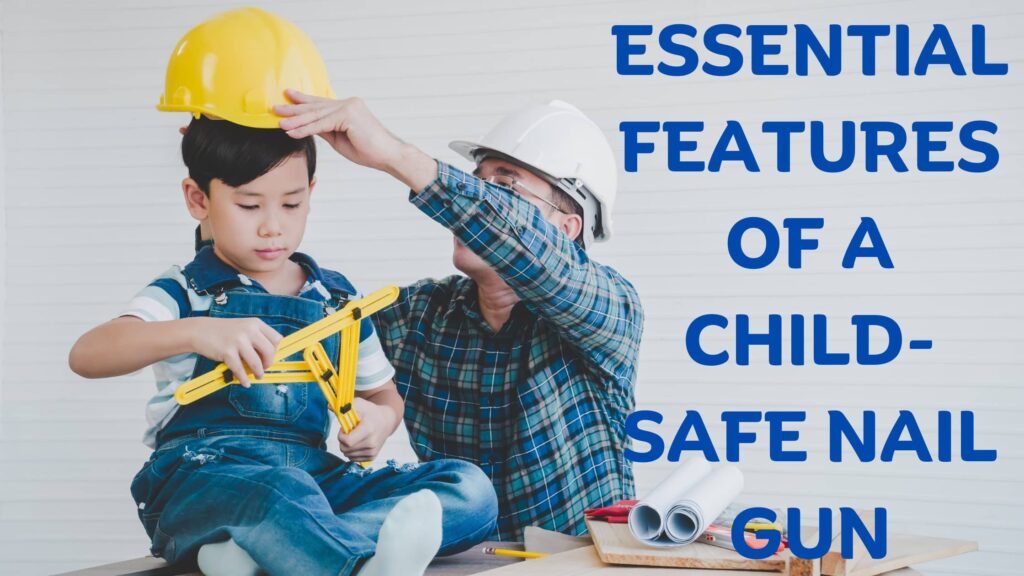
Trigger Locks
Trigger locks disable the firing mechanism, ensuring the nail gun cannot be activated without conscious unlocking by an adult.
Contact-Tip Safety Mechanisms
These mechanisms prevent accidental discharges in open fire. The gun’s tip must be pressed firmly against a surface before firing.
Adjustable Power Settings
Some nail guns feature adjustable power settings to limit force. Lowering the firing force decreases the risk of serious injury if the gun is accidentally discharged.
Safety Indicators
Bright, visible safety indicators, such as lights or symbols, show whether the nail gun is ready to fire. These provide a clear warning when the tool is active.
Child-Resistant Casing
The durable casing prevents children from easily manipulating the tool.
Anti-Dry Fire Technology
Anti-dry fire technology prevents the gun from firing when no nails are loaded. This feature reduces the risk of accidental misfires.
Nail Reload Indicator
Visible indicators help users monitor the number of nails loaded. Overloading the magazine can cause jams and increase the risk of accidents.
Ergonomic Grips
Ergonomic grip designs improve nail gun handling, preventing slips during use and reducing the chances of dropping or misfiring the tool.
Nail Gun Storage
You should have effective nail gun storage plans. You need to specify a storage place where kids can not get any access. Your storage location should be childproofing.
Evaluating Your Home for Hidden Risks of Nail Gun Use
Garages or basements are areas of your home where nail guns might be left unattended and could often become unintended hazards. These spaces need to be secured.
Alongside nail guns, tools like hammers, saws, and drills must also be stored and maintained cautiously.
Determine whether children’s play areas are too close to workshops or nail gun storage areas. Relocate either the play area or the tools to enhance safety.
Sometimes, temporary workstations are set up for short-term tasks. Ensure that these temporary work areas are as secure as permanent ones. Take the same precautions for these areas as a dedicated workshop.
Lastly, if your projects require moving from one room to another, ensure the tools are always under adult control.
Childproofing Your Workshop or DIY Space
- Install safety gates or barriers: Use gates to block your child’s access to areas where tools are stored or used.
- Use locking storage units: Store tools in cabinets or toolboxes with locks that only adults can open.
- Mark safe zones where children are allowed: Designate specific areas in the workshop for children to stay, ensuring they are under supervision.
- Install bright lighting: Proper lighting in your workspace is essential, as it reduces the risk of tripping and serious accidents.
- Set rules about tool use and movement: Establish clear guidelines on when and how tools can be accessed.
- Lock electrical outlets: Prevent children from accidentally powering tools by locking electrical outlets in your workstation.
- Display clear safety guidelines in the workspace: Use posters or signs with simple language and images that children can easily understand to reinforce safety measures.
The Role of Safety Training in Childproofing Nail Guns
Proper safety training can significantly reduce the risks of accidents caused by nail guns. Safety workshops are organized at various locations throughout the year; you can participate in these to better understand how to use tools safely.
If children are old enough, teach them how to handle and monitor tools. Create a comprehensive safety plan that includes clear, easy-to-follow rules for children.
It is greatly beneficial for everyone in the household to educate themselves on the dangers of mishandling nail guns. Videos can be an effective way to teach children about tool safety.
Finally, keep practicing and respecting safety measures, and try using kid-friendly materials, such as toys, to help them learn in a way that suits them.
Using Safety Accessories and Add-Ons
Adding the right safety features to your nail guns can reduce risks:
Trigger Locks
Trigger locks disable the firing mechanism when the nail gun isn’t in use. Install this feature on your nail gun to prevent the accidental discharge of nails.
Protective Guard
Attach guards to the tip of the gun to prevent unintended nails from firing if the tool is bumped.
Non-Slip Grips
If your nail gun handle is slippery, it might slip from your hand and cause accidents. Use grips made of non-slip material to make your tool safer and easier to control.
Nail Gun Cases
Nail guns should be stored in lockable cases to keep them out of reach of children.
Bright Safety Labels
You can add visible warning labels and teach your kids about the signs on the labels so they can spot dangerous tools and stay away from them.
Safety Harness
While working, use a strap or safety harness to avoid dropping or mishandling the nail gun.
Childproof Covers
Nowadays, some covers make nail guns harder for children to access. Use those to add to your safety measures.
DIY Solutions for Childproofing Nail Guns
Apart from expensive accessories and smart technologies, there are also DIY solutions available to make your nail guns safer for your children.
You can attach trigger locks as add-ons to ensure the nail gun is inoperable without removal. These are usually inexpensive and add an extra layer of safety.
There are tamper-proof screws that can easily be installed in your nail guns. These screws will make it harder for children to disassemble the gun.
If your child somehow attempts to grab the tool, use anti-slip covers for the handle so that the nail gun doesn’t fall from their hands.
Also, nails can be very hazardous if they come into your child’s possession. Children can swallow or get injured by the sharp nails. So, use magazine guards and store the nails inside secured storage to keep them away from your child.
Add safety labels to the nail guns and the accessories, and teach the children to understand the signs on the labels. This will restrict them from accessing the dangerous tools and their parts.
You can use magnetic key locks to quickly access the tools. These magnetic key locks are too hard for children to bypass, so it’s a helpful option.
Alternatives to Nail Guns for Safer DIY Projects
If you’re planning to buy a nail gun for your “mini home DIY project” and have children in your home, you might want to reconsider. You can use manual hammers and nails for small-scale projects.
Also, adhesive solutions like glue or double-sided tape can be used for simple tasks that don’t require permanent fastening.
If the hammer and nails don’t seem secure enough to you, consider screwdrivers and screws. Screwdrivers and screws can be more secure than hammer and nails, and they can also be safer than a nail gun.
These are some hand-powered nailers you can consider using for light-duty work.
Finally, while choosing the material for your DIY projects, buy pre-nailed boards or prefabricated materials to minimize the use of tools.
Collaborating with Other Parents and Safety Experts
You can discover new ways to improve safety around nail guns by connecting with others. Exchange childproofing advice with other parents, as they might have similar experiences.
You can join safety seminars or local classes where you can learn and update yourself about the best practices for using tools around children.
For personalized advice, reach out to child safety professionals. This way, you can create a safer workspace. In this modern era, online forums are also of great help. There are groups of parents where you can gain insights and share your thoughts and ideas.
If you want to spread your knowledge on child safety around tools, you can organize events in your community and distribute guides to friends, family, and neighbors.
Lastly, follow blogs, news, or social media channels to keep yourself updated about new safety gear or accessories for your children.
My Final Thoughts on Childproofing Nail Guns
Childproofing your nail guns has some long-term benefits.
Childproofing your nail guns properly can reduce the chances of nail gun-related accidents in your household. This means your household will be safer than ever for your children.
Again, once your children learn safety habits and understand the safety signs, they will also stay cautious in different places like schools or playgrounds.
Proper childproofing sets the foundation for a safer household for future generations and encourages them to develop a responsible attitude toward tools.
Accidents can stress a family’s financial and emotional situation. So, reducing the chance of accidents also minimizes the likelihood of stress in your mind and economic circumstances.
Finally, parents can feel less worried by knowing that the risks are minimized in their home.
